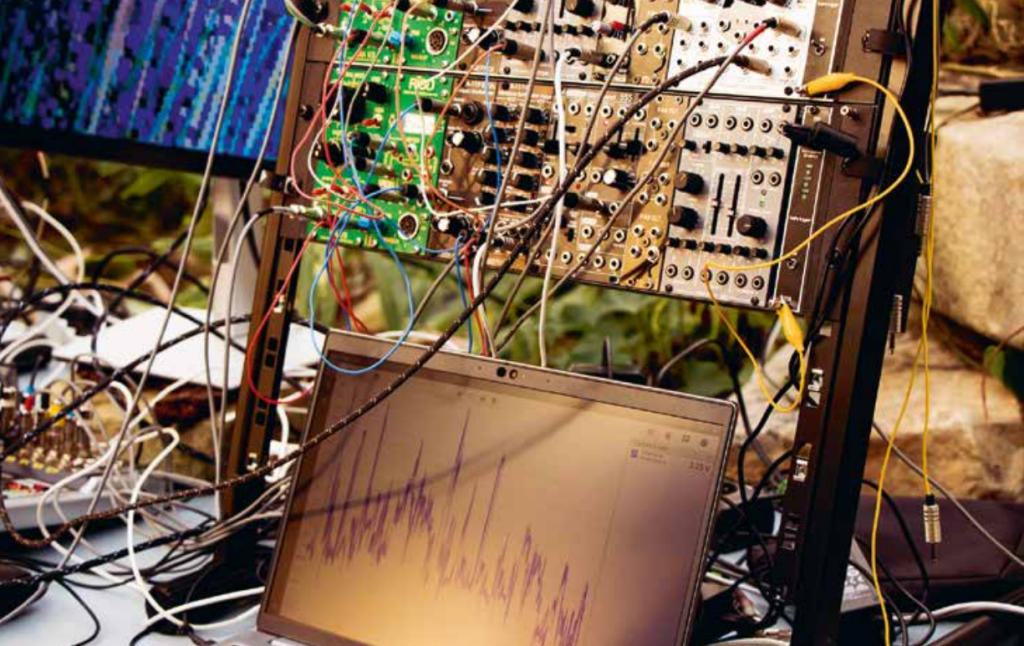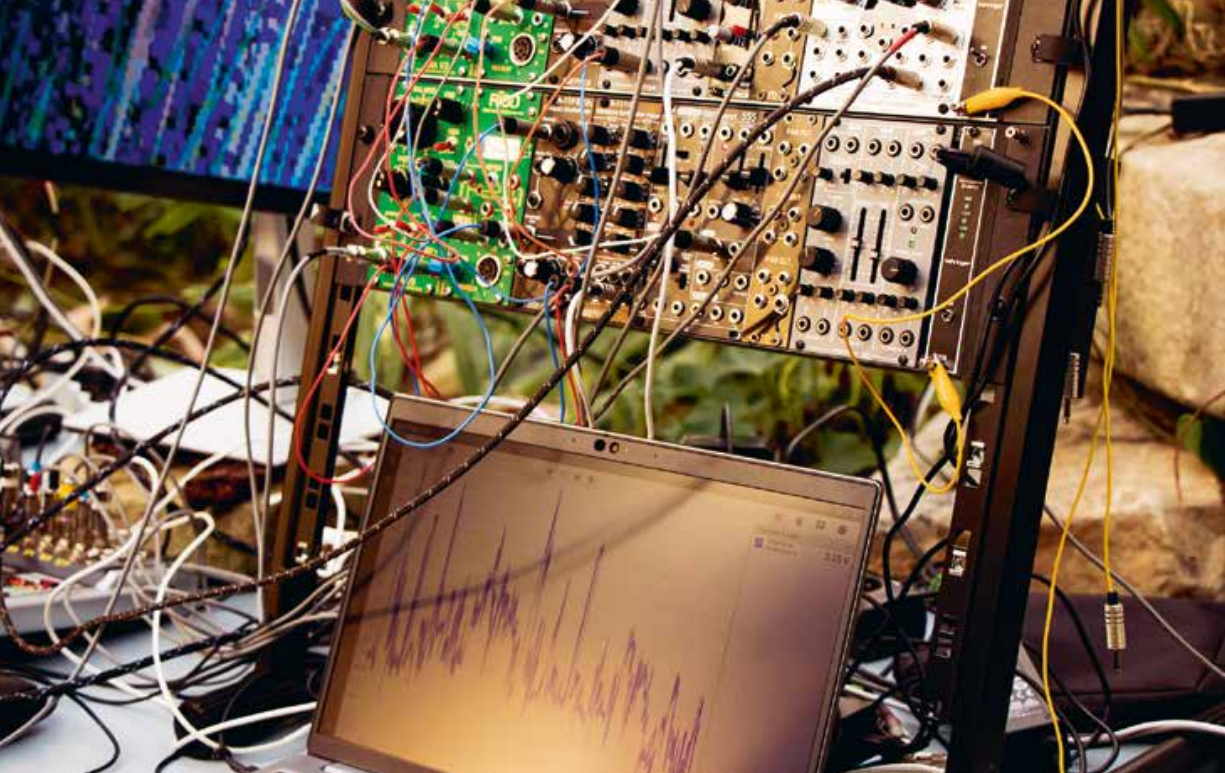
Categorieën: kM 126, Magazine, en Natuur
Tags:
CHRISTIAAN ZWANIKKEN AND RAOUL N. FRESE – Christiaan Zwanikken discovered a rare lavender species in the nature reserve around his studio in Portugal. He became fascinated by what he calls the ‘superior sensuality’ of plants; the way plants react to their environment and how they communicate. The Artscience Lab (VU) is the platform for our collaboration. This article you can find in kM #126 about art & science. Scroll down tot read the full article.
To really connect, and especially with a plant, you need to have patience and time. Visual artist Christiaan Zwanikken (1967) heard plants react to the dripping of a tap and to Chet Baker’s trumpet. By sending a small electric current into a plant and reading the transformations a little further via a loudspeaker, you are informed by the plant. About what? That is completely unclear. Because the effects are exceedingly small, it is important to exclude all other reactions from the surroundings of the plant, and other sources of electricity and noise in the circuits. Only after many months of research, with increasingly extensive equipment, built in collaboration with Marc Marc 1), patterns began to emerge. It is not often that an artist can do more than two years of paid research into the inner world of plants to make a connection with it. Zwanikken got that chance. It led to sometimes amazing experiences. Experiences that can be processed as data for research by scientists or interested parties. Everyone can now experience the results through Zwanikken’s installation Excitation Station: a field equipment for electronic experiments between plants and humans in which the plants determine which signals are generated and how they shape sound and/or image. The installation is the (provisional) result of two years of research and development at the VU Artscience Lab Hybrid Forms.
Scent cannons
Excitation Station had a long run-up that began with Zwanikken’s research into the possibilities of using fragrances and plant substances for experiences and influence: ‘In the continuous search for new synergistic art forms, in which multiple senses are addressed simultaneously, I wanted to know more about the sense of smell, the sense for which, despite previous attempts, I had not yet been able to make convincing work.’ The research resulted in Nose Patrol (2015), an interactive, computer-controlled installation of scent cannons, that create scent compositions in real time that can also be heard and felt, two kinetic sculptures that surround themselves in a choreography with visible and palpable scent clouds and sound. The installation grew into a laboratory for research into the use of smell as a medium. Zwanikken: ‘I wondered if I could develop something that could have positive, beneficial effects on a visitor and became deeply immersed in the plant world and the natural fragrances with their complex compositions and special aromatic and medicinal properties.’
Plant-human-machine interface
Like all living things, plants use electric currents to regulate their inner world, send signals, and control processes. A lot of research is being done on this in plant science, including by Raoul Frese at the Vrije Universiteit (VU) in Amsterdam. In our biophysical laboratory we try to capture this electric current directly with all kinds of materials to make a new and sustainable type of bio-solar cell. In 2020, we expanded this research with Zwanikken’s research in the context of plant-machines. The central question here is: how can plants and people be linked together via machines? Zwanikken started this so-called Smart Hybrid Forms project to develop a plant-human-machine interface for transferring new sensitive experiences from the natural world to the urban environment. Can plants be integrated with electronic readouts to form key data sensors and transducers? 2) Can plants be trained to respond to the presence of certain objects, images, or other living organisms? Which of the approximately 400,000 plant species is most interesting from an electronic point of view? The plant world is a huge source of inspiration; plant-specific behaviour, detection and communication capabilities, processing, control, and energy storage systems. At the same time, by using plants only as examples for robots and modern technologies, we are shortchanging these complex, self-organizing, organisms with only a mechanistic approach. There is a lot of (pseudo)scientific literature about plants and their alleged supersensory perception and interaction. Can any of that be confirmed? Is there really such a thing as biocommunication, communication between living organisms outside the electromagnetic spectrum?
Zwanikken: ‘Due to Covid-19, the VU closed, and I was solely dependent on my studio to develop something with which I could get a “signal” from a plant. But how? On the internet I only found expensive laboratory equipment or plant gadgets whose exact operation was vague. As a little boy I had begged my parents to let me take an electronics course because I was fascinated by the outlandish circuits, I saw in the hobby magazine Elektuur. The course was not a success, I never got anything to work. Suddenly I remembered a diagram of a device with which you could make a plant make a sound. After a lot of research, I found the diagram in the Popular Electronics database where it was published in 1972. The diagram seemed clear, with a limited number of components, buttons, and switches. I built up the circuit of three parts, a sensor circuit, a signal amplifier, and a sound generator (oscillator). After I assembled the electronics, the big moment came: connecting the plant and the first test. The article stated that two round silver-plated plates had to be placed on the sheet. That turned out to be difficult, I designed a special clamp for it. Finally, I was able to connect the batteries; Nothing happened. The diagram listed a whole protocol for operating the switches and buttons. I therefore assumed it was my fault. After trying all settings for days, the plant still did not give a squeak. It became painfully clear that my abstract knowledge of the electrical background of the circuit was sorely lacking. I just did not know what I had made and what I was doing.’
Fellow artist Marc Marc was called in. Marc and Zwanikken have worked together before. After barely five seconds of glance at the schedule, Marc replied with, ‘Oh, but that could be much better. He noticed errors in the schedule that (partly) explained Zwanikken’s failed attempts. Two weeks later, Marc showed a rose branch that he had connected with two wires to a multimeter that read voltages that fluctuated from -12 volts to +12 volts. This was visibly the electrical activity of the rose branch! The sensor was so sensitive that just your breath gave a huge pulse on the meter. A euphoric moment. There was a working circuit as the basis for the prototype: the Versatile Instrumentation Amplifier 1 (VIA1), designed with as many options for experimentation as possible.
Plant detection apparatus
During the lockdowns, Zwanikken worked with the VIA1 for hundreds of hours to understand the overwhelming number of electronic capabilities of the device in relation to the plant. In the process, he developed exotic detection and control systems to increase our empathy for plants and biodiversity in general. For this purpose, state-of-the-art electronic modules have been developed, tailor-made to model and process the signals and reactions of plants in such a way that only one’s own imagination is the limiting factor. A unique feature of the plant detection equipment is that electrical reactions from the plant can be traced back to their own sensor device with so-called Control Voltages (CVs). This idea, borrowed from modular synthesizers, can be used to create complex soundscapes (music) generated entirely by plants. In principle, CVs can control any machine or be linked to digital equipment. At the exhibition Smart Hybrid Forms in Zone2Source, Amsterdam (2022/23) the latest development to use the CVs was presented: to generate ‘Biograms‘, self-composing projected graphic images through plant signals, both in real-time and with previously recorded electrical plant activity.
For the Smart Hybrid Forms exhibition, everything in Excitation Station is analog, nothing is pre-programmed. The electronic modules form an audiovisual, interactive installation in which the control lies entirely with the plants. By putting together, a selection of units, work can also be done on location.
Zwanikken: ‘In the spring of 2022, we went into the great outdoors to experiment with trees. These were long sessions of connecting equipment, adjusting it, turning on the data logger, and then waiting to see what would happen. Far away from electric wiring or posts that always interferes, we were able to amplify the signals much better. We got a clearer picture of the tree’s electrical activity. While waiting, we were able to speculate extensively about what we observed and brainstorm about new experiments. We tried to do that right away. This hands-on way of working guided further development, including for new modules that convert the electrical capacity of trees into sound. By moving with two hands over the trunk, the pitches and timbres of the sound become distant and the tree “becomes like a unique instrument.”‘
At the opening in Zone2Source, the various modules for Excitation Station were ready and everything came together for the first time. Zwanikken was always present for explanation. It was striking that many visitors think that electricity is a human invention instead of a natural phenomenon. Because of this, one could not imagine that plants have electrical properties. During the exhibition, a number of experiments were done. An unexpected development was that the visitor could be involved.
Zwanikken: ‘There were a lot of questions about the experiments that had been done. If I had not already done the proposed experiment, we did it on the spot. This provided interesting information and we will now further integrate this form of participatory experimentation, for example this summer, at the Lowlands Festival!’



